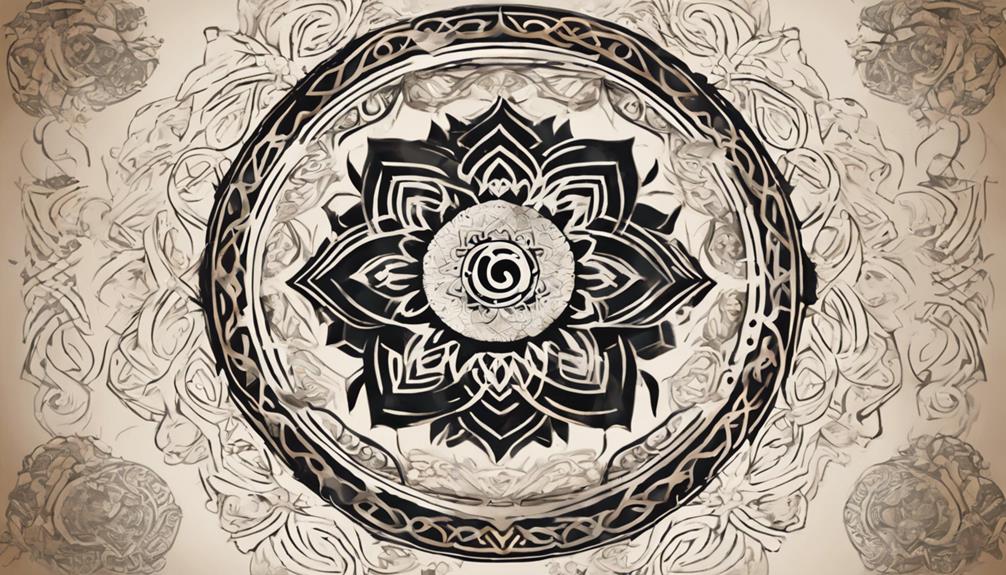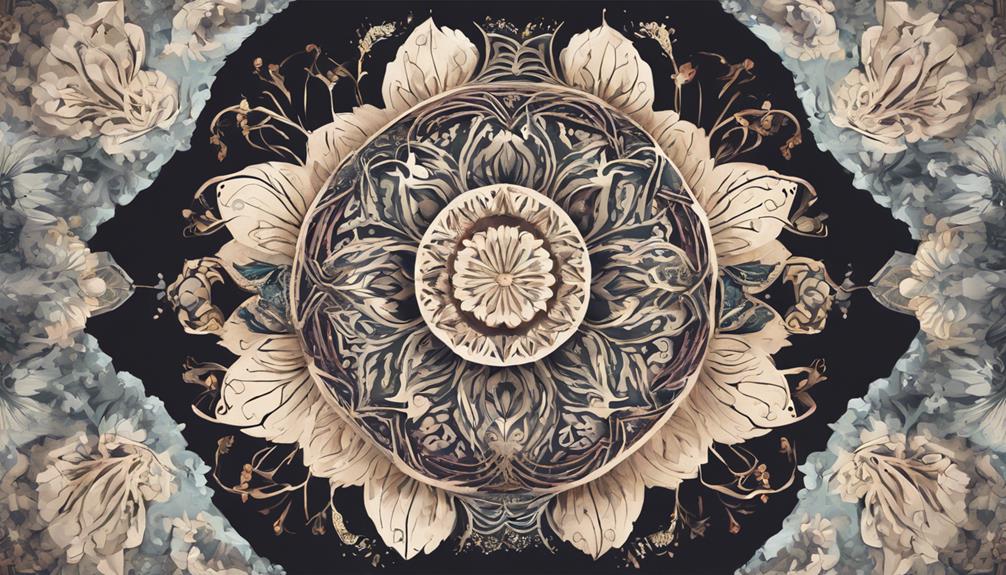Summary
Discover the profound symbolism of mandalas: intricate creations that embody spiritual unity and harmony. Originating in ancient civilizations, these circular symbols reflect the unity and balance of the universe. In Hindu and Buddhist practices, mandalas help focus the mind and connect with the divine. Each element within a mandala has symbolic meaning, promoting inner peace and self-actualization. The transformative power of mandalas enriches mental well-being and deepens spiritual pathways, offering understandings about the individual psyche and the cosmos. Discover the vast meanings and transformative qualities contained in these intricate symbols.
Origin of Mandala symbols

The origin of the symbols of the mandala can be found in the ancient civilizations, where they were used for a variety of spiritual and cultural purposes. These complex geometric designs served as a tool for meditation, representing the universe and theunity of all things within it. In the ancient Hindu and Buddhist traditions, mandalas were created as a visual aid to focus the mind and connect with the divine.
The word 'mandala' itself means 'circle' in Sanskrit, reflecting the Circular nature of these symbols often radiating from a central point. The symmetry and balance found in mandalas is believed to promote a sense of harmony and inner peace.
Through the act of creating or contemplating a mandala, individuals were able to transcend their physical form and access higher states of consciousness. Mandalas were not only used in spiritual practices, but also had significant cultural importance, with different shapes, colors and patterns carrying specific meanings and representing various aspects of the universe and human experience.
Cultural significance and use
Investigates the multifaceted cultural significance and diverse applications of mandala symbols across various traditions and practices. Mandalas have deep cultural significance and are used in a variety of ways across different cultures. Here is a table showing some of the different applications of mandalas:
| Culture/Tradition | Meaning and Usage |
|---|---|
| Hinduism | It represents the cosmos and is used in meditative practices |
| Buddhism | Symbolizes the universe and helps in spiritual orientation |
| Native American | Used in healing rituals and as a symbol of unity |
| Tibetan culture | Used in religious ceremonies and as a tool for meditation |
| Jungian Psychology | It represents the self and is used in therapeutic practices |
These examples demonstrate the versatility and adaptability of mandalas in meeting diverse cultural and spiritual needs. Whether in meditation, healing rituals or psychological exploration, mandalas continue to play an essential role in various traditions around the world.
Symbolism across traditions

Exploring the symbolic meanings of mandalas reveals a rich web of cultural interpretations and spiritual meanings Through various traditions.
- Buddhism: In Buddhism, mandalas are intricate geometric designs representing the universe. They are used as aids in meditation to achieve enlightenment and to chart the spiritual path.
- Hinduism: In Hinduism, mandalas are used in religious rituals and meditative practices. They symbolize the cosmos and the interconnectedness of all living beings.
- Native American Traditions.: Among Native American cultures, mandalas are often found in sand paintings and pottery, carrying spiritual meanings related to healing and storytelling. They are used to connect with ancestors and the natural world.
The diverse symbolism of mandalas across traditions demonstrates the universal concepts of unity, harmony and the interconnectedness of all things. Whether used for meditation, spiritual ceremonies or artistic expression, mandalas serve as powerful symbols that transcend cultural boundaries.
Interpretations and meanings
Investigating the intricate meanings and interpretations of mandalas reveals a world of symbolism that transcends cultural boundaries and explores the essence of unity and interconnectedness. Mandalas are not just geometric patterns; they have profound significance. The circle in the center of a mandala represents the universe, while the intricate patterns around it symbolize harmony and wholeness. Each element within a mandala carries a meaning; squares represent stability, triangles embody energy and change, and circles signify eternity and completeness. Colors also play a crucial role; blue stands for wisdom, red for passion, yellow for intelligence, and green for balance.
Mandalas are often seen as maps for spiritual transformation, guiding individuals toward inner peace and self-actualization. They have the power to calm the mind, reduce stress and promote mindfulness. Meditating on a mandala can reveal hidden meanings and gain insights into one's psyche. Mandalas are not just art; they are portals to a deeper understanding of oneself and the universe.
Transformative power of mandalas

Discover how mandalas possess the transformative power to enrich your mental well-being and deepen your spiritual journey. Mandalas have been used for centuries in different cultures to help individuals in their personal growth and spiritual development. Here are three ways mandalas can have a profound impact on your life:
- Center the Focus: When you engage in creating or meditating on a mandala, it helps center your focus. Intricate patterns draw your attention inward, allowing you to find a sense of calm and clarity in the present moment.
- Emotional Healing: Mandalas serve as a form of art therapy, allowing you to express emotions and thoughts symbolically. Through the process of creating or coloring mandalas, you can release repressed feelings and promote emotional healing.
- Spiritual Connection: The symmetrical design of mandalas represents unity and wholeness. By connecting to a mandala, you can access deeper spiritual awareness, promoting a sense of interconnectedness with the universe.
Personal growth and spiritual development
Delving into the world of personal growth and spiritual development through the practice of mandalas can lead to profound self-discovery and inner transformation. Mandalas act as a mirror for your inner self, reflecting your thoughts, emotions and beliefs. Creating or coloring mandalas can be a meditative process, allowing you to quiet your mind and connect with your deepest emotions.
As you interact with mandalas, you may begin to notice patterns and symbols that resonate with you on a subconscious level. These revelations can provide clarity on aspects of your life that may need attention or healing. By examining these symbols, you embark on a journey of self-awareness and personal growth.
The repetition and symmetry of mandalas can also help calm the mind and reduce stress, fostering a sense of inner peace and tranquility. This inner peace can then extend into your daily life, aiding in spiritual development and a greater sense of connection with the world around you.
Frequently asked questions
Can mandalas be used to heal physical ailments?
Certainly, mandalas can be a powerful healing tool for physical ailments. By focusing on a mandala, you can get in touch with its relaxing, centering energy, which can help reduce stress and promote overall well-being. This feeling of relaxation can have a positive impact on your body, potentially contributing to the healing process. So incorporating mandalas into your healing routine may be just the relaxing touch you need to support your physical health.
Are there specific colors or reasons for manifesting goals?
When manifesting goals with mandalas, choosing colors and patterns that resonate with your intentions can enrich the process. Vibrant colors such as yellow for creativity or blue for tranquility are popular choices. Geometric motifs such as spirals for growth or circles for unity can also be effective. Experiment with different combinations to see what works best for you. Remember, your mandala is a reflection of your desires, so make it personal and meaningful to you.
How do mandalas relate to astrology and zodiac signs?
In the world of theastrology and zodiac signs, mandalas can be fascinating tools for the self-discovery. Each zodiac sign is associated with specific traits, elements and symbols that can be incorporated into the mandala drawings. By creating a mandala that reflects your zodiac sign, you can immerse yourself in the energies and characteristics associated with it, helping you connect more deeply with your astrological identity and explore new aspects of your personality.
Can mandalas be used for meditation by children?
Yes, mandalas can be a great tool for children to use during meditation. They provide a calming and focusing activity that can help children relax and center themselves. Using mandalas for meditation can also foster creativity and self-expression in children. With their intricate designs and soothing colors, mandalas can create a peaceful environment for children to practice mindfulness and cultivate a sense of inner peace.
Are there specific rituals or ceremonies involving mandalas?
Of course, there are various rituals and ceremonies involving mandalas. People often use mandalas in meditation practices to focus the mind and find inner peace. Mandalas can be used in rituals for spiritual purposes, healing ceremonies, or as a way to connect with one's inner self. Creating a mandala can also be a meditative process in itself, helping you relax and center your thoughts. Mandalas have a special meaning in many cultures and practices.
